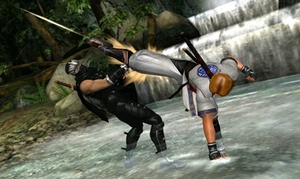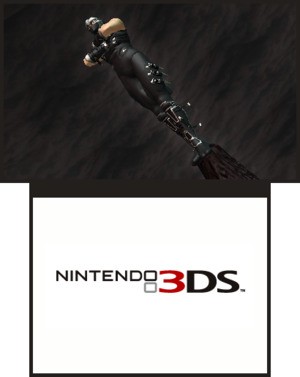
Capcom's Super Street Fighter IV 3D Edition may have been many attendee's standout game of the show, but Tecmo Koei's first portable Dead or Alive title had its fair share of admirers throughout the Discover 3DS event. We put the fighter through its paces and attended Team Ninja's developer roundtable to bring you all the information you need to know.
Dead or Alive: Dimensions captures the series' signature pace and fighting fluidity with aplomb, and the back-and-forth bouts will be instantly familiar to veterans of Tecmo's long-running franchise. With only four command buttons instead of Street Fighter's six, DoA feels at home on the 3DS straight away: there's less finger-knotting than Capcom's title, with easy access to major buttons, but Team Ninja has gone one further with the addition of a touchscreen command list.
Subscribe to Nintendo Life on YouTube841k
The bottom screen houses a full move list, with a scroll bar to navigate, and pulling off anything on the list is as simple as tapping it: multi-throws, holds, wake-up moves and more can all be performed with a tap of the stylus. It's a deceptively simple system, with novices tempted to execute the most complicated-looking command on-screen with no regard for strategy, whereas experts will scroll the list with ease to pick out precisely the right move as necessary.

The list's real strength however is as an interactive reference guide when using the buttons: the bottom screen will highlight possible follow-ups to your attacks, helping you chain moves together without the need to keep referring to a lengthy manual or tutorial. It's almost like a tutorial through fighting: you can see the required commands, tap them to see the CPU execute them or try them yourself. Dead or Alive is arguably a more accessible fighter than the Virtua Fighters of this world, but the touchscreen move list could yet be its best move towards easing new players into a world of complicated multithrows and spectacular juggle combos.
However you choose to control your pugilist, the game looks great with the 3D on or off. When playing with the depth slider all the way to the bottom the game runs at 60 frames per second, but activate the 3D - even just a tiny bit - and the game's framerate switches to 30fps. It's a noticeable change but not as big a problem as it sounds: the game's producer Mr Hayashi explained the game is still calculating at 60fps, so although frames are being dropped it isn't introducing any input delay or causing any other adverse effects.
Seeing the game in 3D is often breathtaking, with the series' trademark spectacle present in spades. Cutscenes show darts, bullets, fireballs and more all flying around with great speed, and destructible arenas mean plenty of impressive transitions between fighting areas, with combatants getting smashed through windows and falling off bridges with great relish.
Dead or Alive: Dimensions also looks set to use the StreetPass feature in an innovative way. As you play the game in single-player, it will begin to build up a picture of your fighting style: your favourite character, attacks and weaknesses, and turn these into an avatar. When passing another DoA player using StreetPass, your avatar will be exchanged with their machine, letting the player take them on later without having to be online. Its closest comparison is a Ghost mode in a racing game, and Hayashi spoke of his hope that players will always have someone new and interesting to play using this mode, even for players unable to access the Internet.
Regrettably the feature that will surely secure Dead or Alive: Dimensions its place in the pantheon of fighting games - that is, the ability to make breasts bounce by shaking the 3DS - was not available in the demo we played, but Hayashi confirmed this is a real feature and one he expects players will enjoy.

Comments 30
So, did Samus make her rumoured appearance on the demo?
DOA alone isn't enough 3D Boobs... that's why we need to see Bloodrayne: The Shroud soon:P
Even though you couldn't do it yourself, did you still see the series' trademark jiggle physics?
@MrMagpie She wasn't in the playable demo but a video revealed her presence later.
@mariofanatic128 I honestly couldn't comment on that
Judging by the emoticon, I'll take that as a yes.
@Waveboy: DOA is the only game so far that changes framerate when switched to 3D(I think) and Super Monkey Ball is definitely 60fps and I think Kid Icarus is too.
I should buy this just to show my M:OM support
I'm still waiting for the real Samus reveal. It sure would be disappointing if the stage announcement weren't followed up with a fully playable character along the lines of Link's appearance in Soul Calibur.
Hahaha last paragraph is win. I look forward to the jiggly boobs most of all, without that it may not be worth getting the game
I'm going to leave this here
[youtube:nyOmIuy3D14]
@WaveBoy Yep, plenty of other 3DS games do 3D at 60fps, but honestly here it sounds a lot more serious than it is. SSFIV3D by comparison runs at 30fps whether 3D is on or off, so at least DoA gives you the option, and both are very responsive and smooth.
RE: Metroid stage - This'll make plenty of you angry, but I know one Nintendo journalist there described Ridley as "that dragon thing" in a news post!
Okay, I'm not even a huge Metroid fan, but: WHAT?! I'd tell that guy "Get it right, douche", and I try not to be vulgar.
Also, 3D dead or alive = the best thing to happen to breasts since Christina Hendricks.
But seriously, for my first real comment:
Touch screen special move input has been around since at least the two Bleach fighting games on the DS, but this system sounds incredible. Unfortunately, it might make flow-chart based fights all the more common. The people who don't need it will already be doing that kind of system, and the people who haven't done something like that may use this as a crutch.
Also, that clip is AWESOME.
Wow, that avatar thing sounds extremely awesome!
Dear Tecmo,
You have my Metroid in your DOA. AND IMMMA LUVEN IT!!!!!!
The last sentence in the article cracks me up...
I just wanna know, is there like a story mode to this game, or is it just mindless fighting and boobs?
There's nothing mindless about Dead or Alive. A lot of thought goes into the fighting and the boobs.
There's story for each of the characters. As well as fighting and boobs.
The boob jiggle did look pretty cool in 3D. XD
Im getting it for the boobs.
I am sold, PERIOD.
Wait... What? Jiggling the 3DS causes in-game boobs to jiggle? (& hopefully real life ones too ) Samus / Metroid: Other M is going to make some sort of appearance in this game? I had never heard either of these things mentioned before... It sounds AMAZING I am officially going to buy DoA before I get any other game available in the launch window, screw SSF!
She still kicks high...
@moomoo123 There's a "Chronicles" mode which is a story mode set throughout the whole DoA saga, complete with cutscenes of people jumping off bridges, throwing shuriken and saying ludicrous things like "if I have to lay down my life to stop you, then so be it!"
Since these comments have already strayed into perv territory...
Enough about the jiggling top halves; I really wish they'd fix those flat butts! Honestly, so much weight up top, yet the DoA girls are amongst the least voluptuous backsides in gaming history.
All I'm sayin' is, they look more ridiculous than erotic. Wario is not impressed, and won't be shaking his 3DS, except in anger.
Yes, there are boobs in this game. Congrats on recognizing them for what they are, it means you have eyes. But please, can we keep the skeezy comments to a minimum? This is a family-friendly site, after all -- keep it in your pants.
note: if your comment still exists here, i am not saying this to you personally, but do keep what i'm saying in mind plz
Think I'll stick to SSFIV
S...Samus!?!? FFFFFFFFFFFF.
Now I feel like I need to play a game that I don't really want. Damn you Tecmo/Nintendo. T_T
Gotta love Samus and Gotta Love Ridley. Way to go Techmo, you sold me on this game. I just hope we get different versions of Samus, Zero Suit, Varia Suit, ect.
shake the 3DS for boob shaking ?
maaaan... thats hilariously pointless.
you can be that 3DS will shake XD
Wow, I'm really excited for this game!
...But everyone here commenting on it makes me feel like a perv for wanting it. =/
Show Comments
Leave A Comment
Hold on there, you need to login to post a comment...